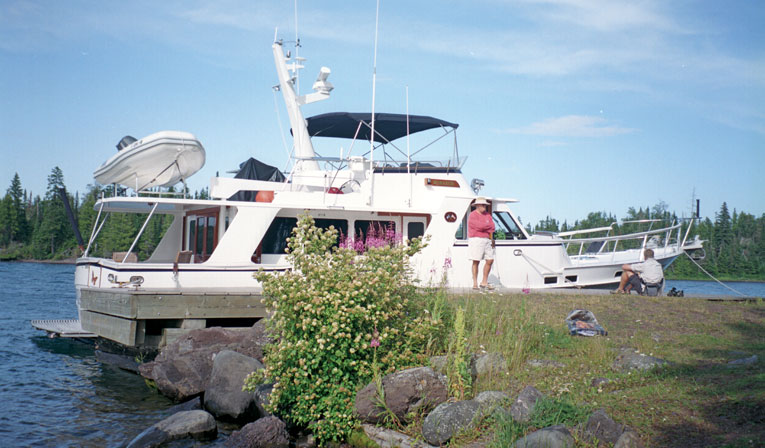Photo by Carl Terhaar
A unique window into one of Lake Superior’s most remote and picturesque destinations.
Native Americans first journeyed to Isle Royale more than 4,000 years ago. If they could have seen a marine chart of the island, they might have imagined that Ursa Major, the Great Bear in the sky, had raked its giant claws across the 45-mile-long island. The resulting parallel rocky ridges are punctuated by long, narrow channels and deep, secure anchorages. Combined with scores of smaller surrounding islands, Isle Royale’s sheltered bays and hideaway harbors make it a gunkholer’s paradise.
In the summer of 2009, my husband, Jerry, and I took a seven-week cruise of Lake Superior aboard our 52-foot Halvorsen raised pilothouse trawler, Monarch. Our visit to remote Isle Royale turned out to be one of the highlights of the cruise. After an 83 nautical mile run from Wisconsin’s Apostle Islands, we approached landfall on Isle Royale’s western tip at Washington Harbor and the Rock of Ages Light.
Among the most remote life stations on the continent, the light was manned by hardy light keepers who lived there for months at a time. The now-automated, solar powered beacon is visible from 20 miles out, standing on a rock reef 117 feet high. This light is an ever-present reminder of the great number of rocks, shoals, reefs and islets that surround the main island. A number of area shipwrecks also attest to the hazardous waters, and wise mariners keep a sharp eye on the charts and the water.
Washington Harbor can be approached via four alternative channels, and we chose the southernmost route through Grace Harbor. At the head of Washington Harbor, we tied up at the sturdy fixed dock at Windigo Ranger Station. Windigo, from Ojibwa legend, represents an evil spirit that haunted the natives during long winters of starvation, causing them to eye their relatives and neighbors as potential meals.
This roadless land of unspoiled forests, pristine inland lakes and rugged, scenic shores is accessible only by boat or seaplane. If you need a crew change here, ferry service is available from the Michigan locations of Houghton or Copper Harbor, or from Minnesota’s Grand Portage. Interestingly, Isle Royale is much closer to Ontario and Minnesota to the north, yet lies within Michigan’s borders.
The island, also known as “the Rock,” was made a National Park in 1940. We registered at Windigo Ranger Station, and filed a tentative float plan for our week-long stay. All park visitors pay a daily fee ($4.00 per person in 2009); throughout the island, sturdy fixed docks in 19 locations are available to boaters for free (that’s right, free!) on a first come, first served basis. On the opposite end of the island, in Rock Harbor, the sole commercial marina has slips available for a fee and also has power, water, diesel and gas. Windigo has gasoline and water.

Photo by Marty Richardson
Map by Tim Piotrowski
Both have token-operated showers, and holding tank pump-out facilities. Private boats usually have a three- to five-night consecutive stay limit per location, and ferryboats have priority in docking at Windigo and Rock Harbor.
To preserve the tranquility of the park, a “leave no trace” policy is in place, and pets are not allowed. Some docks do not allow generators (but you can anchor well off the docks and use one); other docks have restricted late nighttime hours when generators cannot be used. To us, these rules seem to simply mirror consideration for your neighbor and the environment. We didn’t find any policies to be a problem, and found the park staff warm and welcoming.
Windigo’s beautiful visitors’ center displays history and artifacts of the area, including the second order Fresnel lens original to the Rock of Ages Light. One evening we attended an interesting ranger-led discussion at the center about the wolf and moose populations of the island. Moose arrived at Isle Royale early last century, probably swimming from Ontario. With no natural predators, they grew to alarming numbers and nearly deforested the island. Then, in the 1940s, wolves crossed the iced-over lake and proved a formidable opponent. Since their arrival seven decades ago, wolves perform an intricate biological balancing act, well studied by scientists and researchers from nearby Michigan Technological University in Houghton, Michigan.
The island also sustains a remarkable variety of geological and botanical specimens, with more than 700 different species of plant life. Friendly Ranger Shawn helped us identify Canadian dogwood (bunchberry), coral root, cow parsnips, skunk cabbage, red and white (Doll’s Eyes) baneberry, fireweed, shinleaf, and moss spires—all from just one morning’s hike on the Windigo Nature Trail. This self-guided, one-mile loop also highlights the spot where a 1910 hunting and fishing lodge was located, another area where copper prospecting was done in the early 1890s, and the bonsai tree-like effects of moose over-browsing.
After several nights at Windigo, we made our way east about halfway along Isle Royale’s southern shore, to Siskiwit Bay. The day’s predictions were for three-foot waves, but once on Superior, we were in seven-footers. Fortunately we were surfing with the waves for most of the trip. We navigated the well-buoyed channel into Siskiwit Bay and anchored for the night on its north side, in Hay Bay. The small dock and bay is strictly a boaters’ anchorage, with no trails leading to the dock from the rest of the island. This area is billed as a favorite feeding area for moose, but while there we didn’t see any. We did see a pair of American bald eagles, and after a brief afternoon shower, a rainbow. A short walk ashore revealed a number of now defunct fishing homesteads, with occasional artifacts among the wild strawberry plants. Further up the ridge above Finn Point is a beautiful vista of Hay Bay, Siskiwit Bay, Point Houghton and, beyond that, Lake Superior.
Next stop was Caribou Island in Rock Harbor, the 12-mile-long channel that runs parallel to the island’s southeastern side. We easily located the entrance just off Middle Island Passage Light. The island’s 86-foot dock was open and just right for us, with more than nine feet of depth alongside. It is adjacent to the Caribou campsite, where canoers and kayakers occupied the two campsites, their sleeping bags on platforms within the screened and roofed shelters. A fire-ring and picnic tables were dockside, and we shared our homemade cookies with campers around the fire. We were interested to hear their Isle Royale tales, as they were repeat visitors. It’s evident visitors to this idyllic spot are compelled to return again and again.
Today, the park hosts thousands of backpackers who hike the island’s 165 miles of trails each summer. The park has 244 campsites dispersed among 36 campgrounds, so you’re apt to see more campers, kayaks, canoes and small boats than larger cruisers. In fact, the fuel dock attendant at Rock Harbor noted that as of early August, our 52-footer was the largest boat he’d seen all summer. Most days we saw fewer than a dozen people—and enjoyed the solitude.
The next morning, we welcomed friends from the Detroit area, Tamara and Andy Byerly, to our crew in Rock Harbor. They arrived on the Isle Royale Queen, the ferry from Copper Harbor, Michigan, for a few days of wilderness experience.
We loaded their gear aboard and headed past Rock Harbor Lodge, which features 60 rooms and offers the island’s only non-camping public accommodations. A loon was fishing just offshore, and we learned that Isle Royale is home to 100 nesting pairs. Normally solitary creatures, we saw flocks of ten or more loons swimming together throughout our visit.
Our night’s destination was well protected Tobin Harbor, where we had a number of anchorages from which to choose. This area has been a favorite of visitors since the early 1900s, when Isle Royale was a vacation getaway for well-to-do people from Duluth and Chicago. Visitors would come by steamer for the summer, and we could see a few remaining rustic cottages whose occupants have been granted life leases from the Park Service. Today, floatplanes use Tobin and Washington harbors for takeoffs and landings.

Photo by Marty Richardson
This anchorage was convenient for our short dinghy trip to shore and the one-mile uphill hike to Lookout Louise, about 800 feet above lake level. The especially beautiful rocky outcroppings made for good exercise and photo opportunities. The trail winds its way past Hidden Lake, fed by a natural mineral spring, and further on, Monument Rock. This inland sea stack was carved thousands of years ago by the wave action of a much higher Lake Superior.
At the summit is one of the most spectacular vistas in all of Isle Royale. The distant shore of Ontario, Canada is visible from here, and far below a powerboat had carefully worked its way into the anchorage at Duncan Bay.
The next day, we raised the hook and were off to another of the area’s most beautiful anchorages, Chippewa Harbor, located about six nautical miles west of Rock Harbor’s Middle Island Passage. Here, the south shore of Isle Royale is bold and deep with no obstructions. The entrance to Chippewa Harbor features a white triangular day marker that points the way toward the harbor’s two basins. The narrow channel affords good protection from virtually any wind direction throughout the harbor’s numerous anchorages.
The outer basin’s 80-foot dock was occupied, so we carefully picked our way into the innermost harbor through a second narrow, rock-walled channel. Mid-channel depths were 10 to 11 feet. Fortunately, the water here—and throughout Lake Superior—is crystal clear, and underwater visibility is very good. Still, it’s vital to watch your charts and have vigilant visual piloting, as any grounding here will be very hard and very expensive, with help very far away.
Monarch was the only boat anchored in the inner basin for the night. The only other people we saw were two kayakers who stopped by for a chat on their way to portage into Lake Whittlesey. Canoers and kayakers transit the island by portaging from one inland lake to another, or on the rare days when Superior is calm, venturing along the outer shore.
We had fine dining on the aft deck as the wind died, and enjoyed the view of a perfectly mirrored shoreline, followed by a peaceful, very dark night’s sleep. Throughout the island, there is no ambient light at night; ideal conditions for stargazing and meteor watching.
The next day the wind picked up, and we hurried to get under way ahead of predicted high waves. Too late; we surfed down seven- to eight-footers but safely made the trip back to Rock Harbor. Tying up again at Caribou Island, we shared the dock with a 36-foot Grand Banks. It was a tight fit, and we took a line to a large pine tree on shore for extra leverage against the 35-knot wind.
Isle Royale’s boating season commences in late May and lasts through early September. During that time, it’s rare to get a day warm enough for swimming, and particularly so in the cooler-than-normal summer of 2009. Our brave guest Andy jumped off the swim platform into the 57-degree water for the quickest dip we’d ever witnessed, coming up the ladder breathless and blue in just a few seconds. The locals say Labor Day is the best time for swimming, which is also the peak period for visitors. But even then, summer nights are cool and daytime temperatures range from 60 to 75, so be prepared with warm clothes, windbreakers and rain gear. We expected our navigation to be challenged by fog on such cold water, but didn’t see much during our stay.
The next morning we dropped our friends at Rock Harbor for their ferry trip back to Copper Harbor. The wind was whipping the big lake into a frenzy, so we made Monarch fast to the sturdy 144-foot long concrete dock in Moskey Basin—to await more favorable conditions for our mainland crossing.
We heard a moose and her calf had been sighted at nearby Lake Richie, so we set off on the five-mile round trip hike. As novice hikers, we were pleased to find this and other island trails very easily traversed. Once again the moose eluded us, but we enjoyed a beautiful walk under sunny skies. Lake Richie features a campground, and on the trail we passed canoers portaging in from the basin.
Back aboard Monarch’s aft deck, as the wind died, we gazed down the picturesque, three-mile-long Moskey Basin. Alone at the dock, we put our feet up and soon heard a great deal of splashing around the hull. Looking over the side, we spied two otters frolicking in the water, almost close enough to touch. Shortly after sunset we enjoyed the civil twilight and turned in for the night.
Morning was perfectly calm, and just before sunrise, we started the 64 nautical mile trip from Isle Royale to Houghton on the mainland’s Keweenaw Peninsula. We spent eight days on Isle Royale, and only touched a portion of its beautiful bays and harbors. We’ll plan another trip and—winds permitting—visit the north side of the island, where days worth of exploring are yet to be had.


